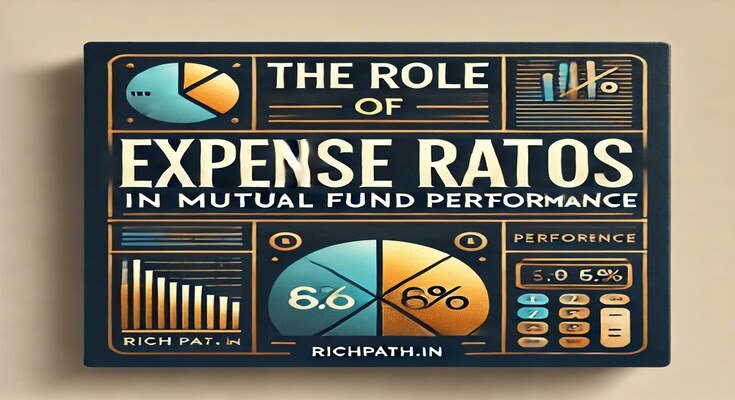The Role of Expense Ratios in Mutual Fund Performance

When investing in mutual funds, many investors focus primarily on returns while overlooking a crucial factor: the expense ratio. This seemingly small fee plays a significant role in mutual fund performance, influencing long-term returns. In this article, we’ll explore how expense ratios affect mutual fund performance, their calculation, and why understanding them is essential for smart investing. With real-world Indian examples, this guide will help you make informed decisions.
What is an Expense Ratio in Mutual Funds?
The expense ratio is the annual fee charged by mutual fund companies for managing your investment. It covers costs such as fund management, administrative expenses, distribution fees, and marketing costs. Since this fee is deducted from the fund’s returns, it directly impacts mutual fund performance over time.
How is the Expense Ratio Calculated?
The formula for calculating the expense ratio is:
Expense Ratio=(Total Expenses of the FundTotal Assets Under Management (AUM))×100\text{Expense Ratio} = \left(\frac{\text{Total Expenses of the Fund}}{\text{Total Assets Under Management (AUM)}}\right) \times 100
Example:
If a mutual fund has an AUM of ₹1,000 crore and incurs total annual expenses of ₹10 crore, the expense ratio is:
101000×100=1%\frac{10}{1000} \times 100 = 1\%
This means ₹1 out of every ₹100 invested in the fund is deducted annually as expenses, reducing overall mutual fund performance.
Why is the Expense Ratio Important?
1. Direct Impact on Returns
The expense ratio is deducted from the fund’s returns. A higher expense ratio reduces your effective earnings, while a lower expense ratio helps retain more returns.
Example:
- Fund A: 10% return, 1.5% expense ratio → Net return = 8.5%
- Fund B: 10% return, 0.5% expense ratio → Net return = 9.5%
The lower expense ratio of Fund B leads to better mutual fund performance.
2. The Power of Compounding
Even a small difference in expense ratios can significantly impact long-term investment growth.
Example:
- Fund A: 12% annual return, 1.5% expense ratio, ₹1,00,000 investment for 20 years.
- Fund B: 12% annual return, 0.5% expense ratio, ₹1,00,000 investment for 20 years.
Outcome:
- Fund A’s corpus: ₹6,97,219
- Fund B’s corpus: ₹8,03,128
Fund B outperforms due to lower expenses, proving that expense ratios significantly affect mutual fund performance over time.
Types of Expenses Included in the Expense Ratio
- Fund Management Fees: Payment to professional fund managers.
- Administrative Expenses: Covers compliance, record-keeping, and operational costs.
- Distribution & Marketing Fees: Costs related to fund promotion.
- Transaction Costs: Charges for buying and selling securities.
SEBI Regulations on Expense Ratios in India
The Securities and Exchange Board of India (SEBI) regulates expense ratios based on a fund’s AUM to ensure fair pricing.
| AUM Slab | Maximum Expense Ratio |
|---|---|
| Up to ₹500 crore | 2.25% |
| ₹500 crore – ₹750 crore | 2.00% |
| ₹750 crore – ₹2,000 crore | 1.75% |
| ₹2,000 crore – ₹5,000 crore | 1.50% |
| Above ₹5,000 crore | 1.05% |
As fund size increases, expenses decrease, improving mutual fund performance.
Expense Ratios in Different Mutual Fund Categories
1. Actively Managed Funds
These funds have higher expense ratios due to active fund management.
Examples:
- HDFC Equity Fund: 1.65%
- ICICI Prudential Bluechip Fund: 1.78%
2. Passively Managed Funds
Index funds and ETFs have lower expense ratios as they replicate an index.
Examples:
- UTI Nifty 50 Index Fund: 0.30%
- SBI ETF Nifty 50: 0.10%
3. Direct Plans vs. Regular Plans
- Direct Plans: Lower expense ratios as they eliminate distributor commissions.
- Regular Plans: Higher expense ratios due to added commission fees.
Example:
- Mirae Asset Large Cap Fund (Direct): 0.54%
- Mirae Asset Large Cap Fund (Regular): 1.78%
Choosing direct plans can enhance mutual fund performance by reducing costs.
How to Evaluate a Mutual Fund Based on Expense Ratio
1. Compare Expense Ratios Within Categories
Select funds with lower expense ratios in the same category.
Example:
- HDFC Top 100 Fund (1.7%) vs. Nippon India Large Cap Fund (1.2%).
2. Focus on Net Returns
A fund with a lower gross return but lower expenses may yield better mutual fund performance.
Example:
- Fund A: 12% return, 2% expense ratio → Net return: 10%
- Fund B: 11.5% return, 1% expense ratio → Net return: 10.5%
Fund B is the better option despite a lower gross return.
3. Consider Long-Term Impact
For long-term investments like retirement planning, minimizing expenses is crucial.
Case Study: Expense Ratios and Mutual Fund Performance
Scenario:
Ramesh and Sunita both invest ₹10 lakh in different mutual funds for 15 years.
- Ramesh’s Fund: 12% return, 2% expense ratio.
- Sunita’s Fund: 11% return, 0.5% expense ratio.
Outcome:
- Ramesh’s Corpus: ₹47.94 lakh
- Sunita’s Corpus: ₹52.69 lakh
Despite a slightly lower return, Sunita’s fund outperforms due to lower expenses, proving that expense ratios significantly impact mutual fund performance.
When to Accept a Higher Expense Ratio?
- Superior Fund Management: If the fund consistently outperforms the benchmark.
- Specialized Investment Strategies: Unique funds may have higher costs.
- Long-Term Outperformance: A fund with higher expenses but higher returns may be justified.
Tips to Minimize Expense Ratios
✔ Choose Direct Plans – Avoid extra distributor fees.
✔ Opt for Index Funds & ETFs – Lower costs compared to active funds.
✔ Diversify Smartly – Avoid unnecessary funds that increase expenses.
✔ Regularly Review Your Portfolio – Ensure your funds remain cost-effective.
Conclusion: The Hidden Cost That Impacts Mutual Fund Performance
Expense ratios significantly influence mutual fund performance over time. While they may seem minor, they can erode long-term returns. Investors should compare expense ratios, evaluate net returns, and choose cost-efficient funds to maximize wealth creation.
By understanding and managing expense ratios, you can optimize your investment strategy and achieve your financial goals more effectively.
Disclaimer
The information provided in this article is for educational purposes only and should not be considered financial advice. Mutual fund investments are subject to market risks, and past performance does not guarantee future results. Readers should consult a certified financial advisor before making investment decisions. Tax laws and regulations are subject to change and vary based on individual circumstances.
For expert financial insights, visit Rich Path. and start your investment journey today! 🚀
Read more –
Top 5 Mutual Funds for Long-Term Growth in India in 2025
Best Mutual Funds: How to Choose – A Complete Guid
Best Flexi Cap Mutual Funds to Invest in 2025








